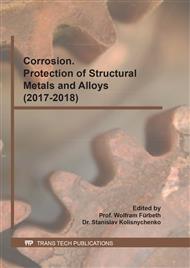p.101
p.107
p.113
p.119
p.125
p.131
p.137
p.145
p.151
Factors Affecting on the Corrosion Resistance of Electroless Ni-Zn-P Coated Steel
Abstract:
Electroless Ni-Zn-P coating with the optimal content of Ni and Zn in the alloy provides high corrosion resistance for steel. Ni-rich phase of this high hardness Ni-Zn-P alloy offers barrier protection property and sacrificial protection property is obtained from the alloy with proper content of Zn. In this work, the Ni-Zn-P coatings were prepared on steel substrates by using alkaline electroless deposition. The parameters of deposition process including complexing agent concentration, bath pH, zinc ion and nickel ion concentration were systematically studied. The microstructural morphology and elemental composition of the coatings were characterized by scanning electron microscopy. It was found that complexing agent, zinc ion and nickel ion concentrations play important role on Zn content of Ni-Zn-P alloy whereas alkalinity of the solution bath directly affects the deposition rate. The results of corrosion resistance investigated by linear polarization illustrate that the corrosion potential (Ecorr) of Ni-Zn-P coatings is negatively shifted by an increase of Zn content in the alloys. From this work, Ecorr of 83%Ni-11%Zn-6%P coating prepared in this system is slightly lower than steel. To achieve a higher effect of sacrificial protection for corrosion protection of steel, Ni-Zn-P with higher content of Zn should be further studied.
Info:
Periodical:
Pages:
125-130
Citation:
Online since:
August 2017
Keywords:
Price:
Сopyright:
© 2017 Trans Tech Publications Ltd. All Rights Reserved
Share:
Citation:



